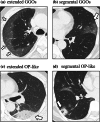Association of subpleural ground-glass opacities with respiratory failure and RNAemia in COVID-19
- PMID: 36735038
- PMCID: PMC9896440
- DOI: 10.1007/s00330-023-09427-0
Association of subpleural ground-glass opacities with respiratory failure and RNAemia in COVID-19
Abstract
Objectives: To examine the radiological patterns specifically associated with hypoxemic respiratory failure in patients with coronavirus disease (COVID-19).
Methods: We enrolled patients with COVID-19 confirmed by qPCR in this prospective observational cohort study. We explored the association of clinical, radiological, and microbiological data with the development of hypoxemic respiratory failure after COVID-19 onset. Semi-quantitative CT scores and dominant CT patterns were retrospectively determined for each patient. The microbiological evaluation included checking the SARS-CoV-2 viral load by qPCR using nasal swab and serum specimens.
Results: Of the 214 eligible patients, 75 developed hypoxemic respiratory failure and 139 did not. The CT score was significantly higher in patients who developed hypoxemic respiratory failure than in those did not (median [interquartile range]: 9 [6-14] vs 0 [0-3]; p < 0.001). The dominant CT patterns were subpleural ground-glass opacities (GGOs) extending beyond the segmental area (n = 44); defined as "extended GGOs." Multivariable analysis showed that hypoxemic respiratory failure was significantly associated with extended GGOs (odds ratio [OR] 29.6; 95% confidence interval [CI], 9.3-120; p < 0.001), and a CT score > 4 (OR 12.7; 95% CI, 5.3-33; p < 0.001). The incidence of RNAemia was significantly higher in patients with extended GGOs (58.3%) than in those without any pulmonary lesion (14.7%; p < 0.001).
Conclusions: Extended GGOs along the subpleural area were strongly associated with hypoxemia and viremia in patients with COVID-19.
Key points: • Extended ground-glass opacities (GGOs) along the subpleural area and a CT score > 4, in the early phase of COVID-19, were independently associated with the development of hypoxemic respiratory failure. • The absence of pulmonary lesions on CT in the early phase of COVID-19 was associated with a lower risk of developing hypoxemic respiratory failure. • Compared to patients with other CT findings, the extended GGOs and a higher CT score were also associated with a higher incidence of RNAemia.
Keywords: COVID-19; CT; Ground-glass opacity; Respiratory failure; Severe pneumonia.
© 2023. The Author(s), under exclusive licence to European Society of Radiology.
Conflict of interest statement
The authors of this manuscript declare no relationships with any companies whose products or services may be related to the subject matter of the article.
Figures




Similar articles
-
CT image of novel coronavirus pneumonia: a case report.Jpn J Radiol. 2020 May;38(5):407-408. doi: 10.1007/s11604-020-00945-1. Epub 2020 Mar 18. Jpn J Radiol. 2020. PMID: 32189175 Free PMC article.
-
Circulating Type I Interferon Levels in the Early Phase of COVID-19 Are Associated With the Development of Respiratory Failure.Front Immunol. 2022 Feb 14;13:844304. doi: 10.3389/fimmu.2022.844304. eCollection 2022. Front Immunol. 2022. PMID: 35237279 Free PMC article.
-
Involvement of the Mediastinal Subpleural Pulmonary Parenchyma on Chest CT in COVID-19 patients: A Case Series.J Radiol Case Rep. 2020 Nov 30;14(11):1-15. doi: 10.3941/jrcr.v14i11.3974. eCollection 2020 Nov. J Radiol Case Rep. 2020. PMID: 33708340 Free PMC article.
-
Similarities and Differences of Early Pulmonary CT Features of Pneumonia Caused by SARS-CoV-2, SARS-CoV and MERS-CoV: Comparison Based on a Systemic Review.Chin Med Sci J. 2020 Sep 30;35(3):254-261. doi: 10.24920/003727. Chin Med Sci J. 2020. PMID: 32972503 Free PMC article.
-
Coronavirus Disease 2019 (COVID-19): A Systematic Review of Imaging Findings in 919 Patients.AJR Am J Roentgenol. 2020 Jul;215(1):87-93. doi: 10.2214/AJR.20.23034. Epub 2020 Mar 14. AJR Am J Roentgenol. 2020. PMID: 32174129
Cited by
-
High interleukin-6 levels induced by COVID-19 pneumonia correlate with increased circulating follicular helper T cell frequency and strong neutralization antibody response in the acute phase of Omicron breakthrough infection.Front Immunol. 2024 Apr 17;15:1377014. doi: 10.3389/fimmu.2024.1377014. eCollection 2024. Front Immunol. 2024. PMID: 38694512 Free PMC article.
-
Dominant CT Patterns and Immune Responses during the Early Infection Phases of Different SARS-CoV-2 Variants.Viruses. 2023 May 31;15(6):1304. doi: 10.3390/v15061304. Viruses. 2023. PMID: 37376606 Free PMC article.
-
Extracellular DNA, hyaluronic acid, HIF pathways, and LncRNAs as predictive biomarkers of severe COVID-19.Virol J. 2025 Jul 23;22(1):252. doi: 10.1186/s12985-025-02886-5. Virol J. 2025. PMID: 40702494 Free PMC article. Review.
-
Artificial intelligence-based analysis of the spatial distribution of abnormal computed tomography patterns in SARS-CoV-2 pneumonia: association with disease severity.Respir Res. 2024 Jan 10;25(1):24. doi: 10.1186/s12931-024-02673-w. Respir Res. 2024. PMID: 38200566 Free PMC article.
-
Evaluating the Accuracy of Chest CT in Detecting COVID-19 Through Tracheobronchial Wall Thickness: Insights From Emergency Department Patients in Mid-2023.Cureus. 2024 Sep 11;16(9):e69161. doi: 10.7759/cureus.69161. eCollection 2024 Sep. Cureus. 2024. PMID: 39398816 Free PMC article.
References
Publication types
MeSH terms
Grants and funding
LinkOut - more resources
Full Text Sources
Medical
Miscellaneous

